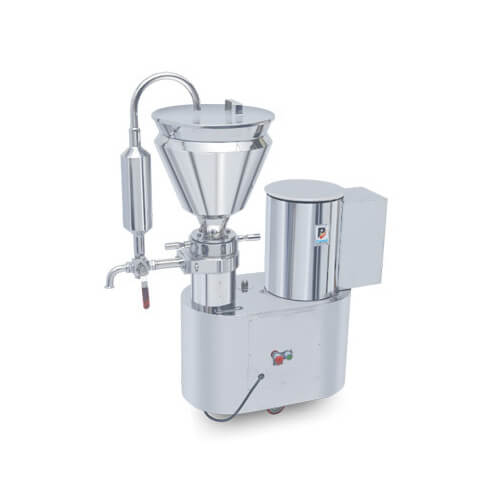The colloid mill’s primary function is that through the relatively high-speed movement between the rotor and stator, the fluid or semi-fluid materials undergo strong cutting force, friction force, and high-speed vibration, which crushes, emulsifies, homogenises, and temperatures the materials to obtain satisfactory results. The stator, rotor, body shell, cooling system, adjustment system and motor comprise the primary machine. To acquire a decent result, customers choose different colloid mill specifications based on different textures of materials, production efficiency, and usages.
Working Principle
The functioning principle of Colloid Mill is that due to the material’s weight and the spiral impact of outside pressure, the motor drives the gear over the bucket and moves high-speed relative to the stator to the split between stator and rotor, which produces a powerful cutting force, friction and high-speed vibration. At finally, fine grinding and emulsion smash the materials.
The colloid mill, in comparison to the pressure homogenizer, is an eccentric piece of equipment at first. Its benefits include a simple structure and ease of maintenance, as well as the ability to accommodate materials with high viscosity or large particle sizes. The structure determines its main shortcomings. Due to the eccentric fourth, the rate of flow is initially not constant, resulting in large fluctuations in flow material with the same viscosity. Secondly, because the high frictional force between the rotor and the materials makes it easy to generate a great deal of heat and induce material denaturation. The third advantage is that the surface is easier to wear and the grinding effect is lessened.
Structure of Colloid Mill
The transmission base parts, motor and grinding head make up the colloid mill machine. The material portions that come into touch are comprised of steel. The most crucial components are the stator and rotor grinding blades. The physical qualities of the materials influence the shape of grinding blades. Stainless steel is also used for the texturing on the blades. A water blocking plate is fitted on the swelling cover of the motor to prevent leaking, and the motor was designed to satisfy the special needs of a colloid mill.
Maintenance of Colloid Mill
High-Precision Colloid Machines are high line speeds up to 20 metres per second, and the divide between grinder blades is thin. The inaccuracy of coaxially of the shell surface body with the spindle is less than 0.05mm after examination and repair, which should be confirmed with a dial gauge.
To avoid harming the easy-to-wear portions, a wooden hammer should be used or padded with a block of wood. Unpacking the rotor or stator requires special tools.
Static and dynamic sealing is used to seal the machine. The mechanic and cooperation seals are used in dynamic sealing.
According to the material’s state, this machine should be maintained regularly. The period for use can be prolonged without replacing the materials.
In the pharmaceutical, cosmetics, suspensions, and emulsion industries, the colloid mill is used for superfine grinding, homogenising, emulsifying, dispersing, mixing, and extracting liquids, ointments, and highly viscous goods. Promas is a well-known manufacturer of high-performance colloid mills.




